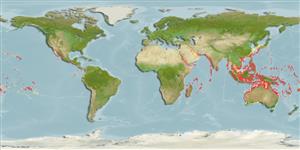Common names from other countries
Environment: milieu / climate zone / depth range / distribution range
экология
; пределы глубины 1 - 50 m (Ref. 100964). Tropical
Indo-Pacific. The form occurring from the Red Sea to the Gulf of Oman is usually distinguished under the name Cerithium erythraeonense.
Length at first maturity / Size / Вес / Возраст
Maturity: Lm ? range ? - ? cm Max length : 15.0 cm SHL самец/пол неопределен; (Ref. 349); common length : 12.0 cm SHL самец/пол неопределен; (Ref. 349)
Commonly collected in the Indo-West Pacific, for food and shell trade (Ref. 349). Usually near the outer edge of reefs (Ref. 349). Also found on open reef flats (Refs. 799, 75835).
Life cycle and mating behavior
половая зрелость | размножение | нерест | икра | Fecundity | личинки
Members of the order Neotaenioglossa are mostly gonochoric and broadcast spawners. Life cycle: Embryos develop into planktonic trocophore larvae and later into juvenile veligers before becoming fully grown adults.
Основная ссылка
ссылки | координатор | соавторы
Poutiers, J.M. 1998. (Ref. 349)
Статус Красного Списка МСОП (Ref. 130435)
Статус СИТЕС (Ref. 108899)
Not Evaluated
Not Evaluated
Угроза для людей
Harmless
Использование человеком
рыболовство: коммерческий
| FishSource |
инструменты
дополнительная информация
Возраст/РазмерыростЗависимость между длиной и массой телаЗависимость между длинамиморфологияличинкичисленность
ресурсы в Интернет
Estimates based on models
Preferred temperature
(Ref.
115969): 24.5 - 29, mean 28 (based on 1108 cells).
Уязвимость
Low vulnerability (10 of 100).
Категория цены
Unknown.
